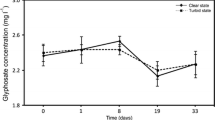Abstract
Aquatic treatment indicated that the efficiency ofL. gibba in algal removal was higher in mixtures of Nile and wastewater systems and the percent algal reduction ranged from 86 to 90%. The maximum percentage of algal removal was achieved with a water system with an equal mixture of Nile and wastewater, this was followed by the water system with Nile to wastewater in a ratio of 1∶3 (89%). The data further revealed that the most highly predominant species were contributed byBacillariophyta. L. gibba treatment of the wastewater induced a reduction in the total species number of phytoplankton populations to only 5 species of diatoms with the order of dominance as follows:Synedra ulna, Navicula cryptocephala, Nitzschia acicularis, Melosira granulatus andCyclotella glomerata.
Similar content being viewed by others
References
Abdel Hamid M.: Ecological studies on the algal population of Damietta branch and the possibility of their use as water pollution indicators.MSc Thesis. Mansura University 1986.
Abdel Hameed M.S.: Response of some Nile phytoplankton communities to biologically treated wastewater with aquatic weeds.MSc Thesis. Cairo University (Beni-Suef Branch) 1993.
Chapman V.J., Chapman D.J.:The Algae, 2nd ed. Macmillan Press Ltd., London 1988.
Culley D.D., Epps A.E.: Use of duckweed for waste treatment and animal feed.J. Water Pollut. Control Feder. 45, 337–347 (1973).
El-Ayouty E., Ayyad E.: River phytoplankton, pp. 131–137 inAnnual Report and River Nile Project. III. River Ecosystem Studies. Egyptian Assoc. Sci. & Technol., Cairo 1976.
El-Nabarawy M.T., Welter A.N.:Utilization of Algal Cultures and Assays by Industry (Algae as Ecological Indicator) (E. Shubert, Ed.) Academic Press, London 1984.
El-Attar S.A.: Ecophysiological studies on some Nile fresh water algae as affected by some industrial effluents at Helwan region.PhD Thesis. Cairo University 1991.
Fayed S., Shehata S.: River eutrophication, pp. 121–126 inAnnual Report and River Nile Project. III. River Ecosystem Studies. Egyptian Assoc. Sci. & Technol., Cairo 1976.
Ferrara L., Forgione P., Schettino O., Rullo V.: The use of aquatic plants in wastewater treatment adsorption of zirconium and cadmium.Bullettion della Societa Italiana di Biologia Sperimentale 61, 1343–1348 (1985).
Kobbia I.A., Hassan S.K.M., Shoulkamy M.A.: Standing crop and distribution of phytoplankton in relation to nutritional status of a polluted drain at Minia Province (Upper Egypt).Bull. Fac. Sci. Assiut Univ. 19, 247–264 (1990).
Mitchell D.: Algal bioassays for estimating the effect of add materials upon planktonic algae in surface waters, pp. 153–158 inBioassay Techniques and Environmental Chemistry (G. Glass, Ed.). Ann Arbor Sci. Publ., Michigan 1974.
Mohamed A.A., Ahmed A.M., Ahmed Z.A.: Studies on phytoplankton of the Nile system in upper Egypt.Limnology 17, 99–117 (1986).
Oron G., Willers H.: Effect of wastes quality on treatment efficiency with duckweed.Water Sci. Technol. 21, 63–641 (1989).
Palmer C.M.: A composite rating of algae tolerating to organic pollution.J. Phycol. 5, 79–82 (1969).
Riley G.A.: Phytoplankton of Long Island Sound.Bull. Bringh. Oceangi Cell 19, 5–34 (1967).
Shannon C.E., Weaver W.:The Mathematical Theory of Communities. University of Illinois Press, Springfield (Illinois) 1963.
Stanley A.R., Madewell E.C.: Optimum dilution of swine wastes for growth ofLemna minor L. andEuglena sp., pp. 331–333 inManaging Livestock. Proc. 3rd Internat. Symp. Livestock Wastes. American Society of Agricultural Engineers, St. Joseph (Michigan) 1975.
Viet N., Warren P., Hancock S.: TheLemna technology for wastewater treatment, p. 292 inEnvironmental Engineering NATL Conference, Vancouver 1988.
Weber A.S., Tchobanoglous G.: Nitrification in water hyacinth treatment systems.J. Environ. Eng. Div. Am. Soc. Civil. Eng. 11, 699–703 (1985).
Willen T.: Studies on the phytoplankton of some lakes connected with or recently isolated from the Baltic.Oikos 13, 98–104 (1962).
Zirschky J., Reed S.C.: The use of duckweed for wastewater treatment.J. Water Pollut. Control Feder. 60, 1253–1258 (1988).
Author information
Authors and Affiliations
Rights and permissions
About this article
Cite this article
Hammouda, O., Abdel-Hameed, M.S. Response of phytoplankton populations to aquatic treatment byLemna gibba . Folia Microbiol 39, 420–427 (1994). https://doi.org/10.1007/BF02814450
Received:
Revised:
Issue Date:
DOI: https://doi.org/10.1007/BF02814450




